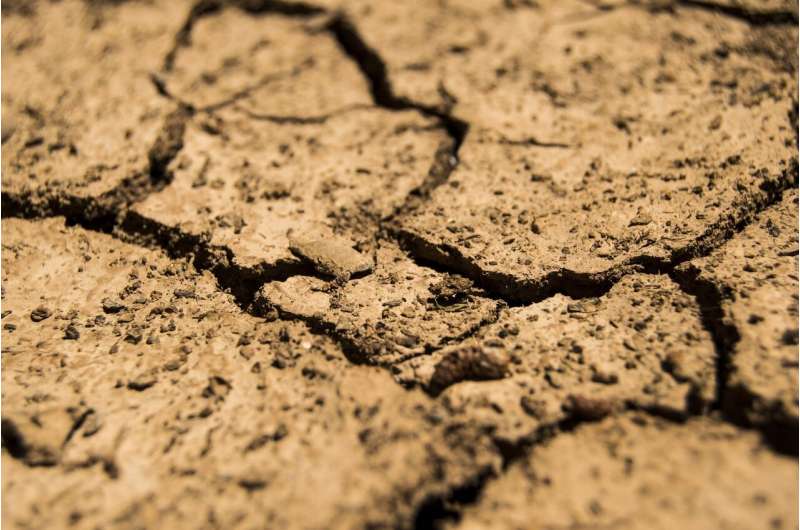This article has been reviewed according to Science X's editorial process and policies. Editors have highlighted the following attributes while ensuring the content's credibility:
fact-checked
peer-reviewed publication
reputable news agency
proofread
Dirty truth: Study suggests new way climate change is fueling itself

Healthy, undisturbed soil sinks carbon, storing what's generated when plants and other living things decompose so it doesn't get released as a planet-warming greenhouse gas.
But a new study out of UC Riverside suggests nitrogen pollution from cars and trucks and power plants might make soil release that carbon in Southern California and other similarly dry places—worsening, rather than helping to fight, climate change.
Dryland ecosystems like ours cover roughly 45% of land on Earth. They also store 33% of the carbon found in the top layer of soil worldwide. So if nitrogen pollution is making the carbon stored in these soils vulnerable, that definitely rings some alarm bells, said Peter Homyak, an environmental sciences professor at UC Riverside who co-authored the study.
The findings offer new motivation, then, to speed the transition away from fossil fuels and cut back on nitrogen-rich fertilizer if we want to slow global warming that's already creating climate refugees due to worsening heat waves, droughts, floods and wildfires.
"Our study highlights once again how nitrogen pollution can affect even the non-living environment around us, beyond the well-established detrimental effects of air pollution on us humans," said Johann Püspök of Austria, who started the study while he was Homyak's student at UC Riverside. "So, getting a grip on air pollution and fertilizer overuse is still an important task."
In places that get more regular rain and snow, other studies have shown that adding nitrogen to soil can increase carbon storage. Nitrogen fuels plant growth, which captures carbon and draws it down into the soil. It also helps slow decomposition of whatever is in the soil.
That's not what happened when Püspök's team analyzed nitrogen-enriched soil across Southern California, which has some of the worse nitrogen pollution levels in the world.
They took samples from areas at Irvine Ranch National Landmark in Orange County, Sky Oaks Field Station in San Diego County and Santa Margarita Ecological Reserve in Riverside County that have been fertilized with nitrogen in long-term experiments to study the effects of such pollution.
Püspök's team found that while adding nitrogen to soil in drylands did still increase plant growth and decrease decomposition, it did not increase the amount of carbon stored in the soils. Instead, they found extra nitrogen caused some dryland soil to acidify, then leach calcium as it tried to rebalance its pH levels. Since calcium binds to carbon, the two elements left the soil together, sending previously sequestered carbon into the atmosphere.
Carbon bound to calcium and other minerals in soils has previously been thought to be pretty stable, Homyak said. That's because the minerals seem to help hide carbon from microbes, which otherwise feed on decaying plant and animal matter and release that carbon in the process. Dryland soil also has been thought to be good at buffering itself from too much acidification. So Homyak said learning that nitrogen could upend both of those bits of accepted wisdom was concerning.
In the San Diego study area, the report published in the journal Global Change Biology says the team saw a 16% drop in once-stable carbon in the soil when it absorbed nitrogen.
"That means bare patches of soil with no plant cover and low microbial activity, which I always thought of as areas where not much is going on, appear to be affected by nitrogen pollution, too," Püspök said.
It's a tricky balance, Homyak acknowledged, since nitrogen fertilizers in agricultural sites do increase plant production. But use too much, and he said that nitrogen can end up all over the surrounding land, potentially triggering the acidification his team saw.
Even in places where fertilizer isn't being added to soil, nitrogen is increasingly present in the atmosphere. Thanks to modern industrial and agricultural practices and the advent of vehicles, the study states levels of nitrogen in Earth's atmosphere have tripled since 1850.
More research is needed to see if dryland soil emits carbon the same way when it gradually absorbs nitrogen in the atmosphere vs. when nitrogen is added to the soils all at once through fertilizer, as with samples the UC Riverside team tested. But Homyak said they expect the process to be pretty similar, since atmospheric nitrogen can build up, then get dumped in substantial amounts during the first big rain of the season.
There's no easy way to remediate soil that's acidified by nitrogen, Homyak said. You'd need to make the soil more alkaline. But short of having helicopters dump lime or some such substance on these lands, he said the only thing that will help is reducing emissions in the atmosphere and then giving the soil time to repair itself.
That's a very slow process. So Homyak said there's no time like the present to get started.
Journal information: Global Change Biology
2023 MediaNews Group, Inc.
Distributed by Tribune Content Agency, LLC.




















